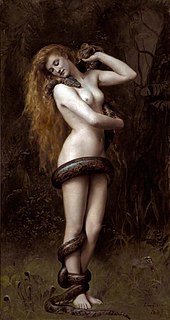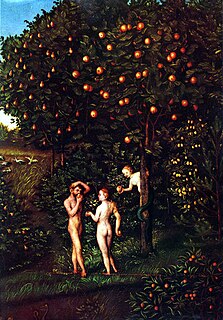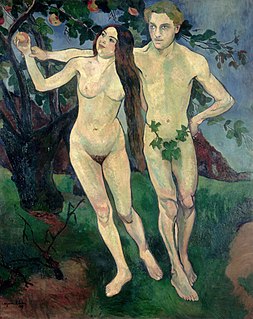
Lilith is a female figure in Mesopotamian and Judaic mythology, alternatively the first wife of Adam and supposedly the primordial she-demon. Lilith is cited as having been "banished" from the Garden of Eden for not complying with and obeying Adam. She is thought to be mentioned in Biblical Hebrew in the Book of Isaiah, and in Late Antiquity in Mandaean mythology and Jewish mythology sources from 500 CE onward. Lilith appears in historiolas in various concepts and localities that give partial descriptions of her. She is mentioned in the Babylonian Talmud, in the Book of Adam and Eve as Adam's first wife, and in the Zohar Leviticus 19a as "a hot fiery female who first cohabited with man". Many traditional rabbinic authorities, including Maimonides and Menachem Meiri, reject the existence of Lilith.

Paradise Lost is an epic poem in blank verse by the 17th-century English poet John Milton (1608–1674). The first version, published in 1667, consists of ten books with over ten thousand lines of verse. A second edition followed in 1674, arranged into twelve books with minor revisions throughout. It is considered to be Milton's masterpiece, and it helped solidify his reputation as one of the greatest English poets of all time. The poem concerns the biblical story of the Fall of Man: the temptation of Adam and Eve by the fallen angel Satan and their expulsion from the Garden of Eden.
A protoplast, from ancient Greek πρωτόπλαστος, in a religious context initially referred to the first human or, more generally, to the first organized body of progenitors of mankind, or of surviving humanity after a cataclysm.

In human genetics, the Mitochondrial Eve is the matrilineal most recent common ancestor (MRCA) of all living humans. In other words, she is defined as the most recent woman from whom all living humans descend in an unbroken line purely through their mothers and through the mothers of those mothers, back until all lines converge on one woman.

In Judaism and Christianity, the tree of the knowledge of good and evil is one of two specific trees in the story of the Garden of Eden in Genesis 2–3, along with the tree of life. Alternatively, some scholars have argued that the tree of the knowledge of good and evil is just another name for the tree of life.
In human genetics, the Y-chromosomal most recent common ancestor is the patrilineal most recent common ancestor (MRCA) from whom all currently living humans are descended. He is the most recent male from whom all living humans are descended through an unbroken line of their male ancestors. The term Y-MRCA reflects the fact that the Y chromosomes of all currently living human males are directly derived from the Y chromosome of this remote ancestor. The analogous concept of the matrilineal most recent common ancestor is known as "Mitochondrial Eve", the most recent woman from whom all living humans are descended matrilineally. As with "Mitochondrial Eve", the title of "Y-chromosomal Adam" is not permanently fixed to a single individual, but can advance over the course of human history as paternal lineages become extinct.
The Life of Adam and Eve, also known in its Greek version as the Apocalypse of Moses, is a Jewish apocryphal group of writings. It recounts the lives of Adam and Eve from after their expulsion from the Garden of Eden to their deaths. It provides more detail about the Fall of Man, including Eve's version of the story. Satan explains that he rebelled when God commanded him to bow down to Adam. After Adam dies, he and all his descendants are promised a resurrection.
The Apocalypse of Adam, discovered at Nag Hammadi in Upper Egypt in 1945, is a Sethian work of Apocalyptic literature dating to the first-to-second centuries AD. This tractate is one of five contained within Codex V of the Nag Hammadi library.

Forbidden fruit is a name given to the fruit growing in the Garden of Eden which God commands mankind not to eat. In the biblical story, Adam and Eve eat the fruit from the tree of the knowledge of good and evil and are exiled from Eden.
And the Lord God commanded the man, saying, Of every tree of the garden thou mayest freely eat: But of the tree of the knowledge of good and evil, thou shalt not eat of it: for in the day that thou eatest thereof thou shalt surely die.

The expression "fig leaf" is widely used figuratively to convey the covering up of an act or an object that is embarrassing or distasteful with something of innocuous appearance, a metaphorical reference to the Biblical Book of Genesis in which Adam and Eve used fig leaves to cover their nudity after eating the forbidden fruit from the tree of the knowledge of good and evil. Some paintings and statues have the genitals of their subjects covered by a representation of an actual fig leaf or similar object, either as part of the work or added afterward for perceived modesty.

Adam is the name given in Genesis 1-5 to the first human. Beyond its use as the name of the first man, adam is also used in the Bible as a pronoun, individually as "a human" and in a collective sense as "mankind". Genesis 1 tells of God's creation of the world and its creatures, including adam, meaning humankind; in Genesis 2 God forms "Adam", this time meaning a single male human, out of "the dust of the ground", places him in the Garden of Eden, and forms a woman, Eve, as his helpmate; in Genesis 3 Adam and Eve eat the fruit of the tree of knowledge and God condemns Adam to labour on the earth for his food and to return to it on his death; Genesis 4 deals with the birth of Adam's sons, and Genesis 5 lists his descendants from Seth to Noah.

Eve is a figure in the Book of Genesis in the Hebrew Bible. According to the origin story of the Abrahamic religions, she was the first woman, yet some debate within Judaism has also given that position to Lilith. Eve is known also as Adam's wife.

Adam and Eve, according to the creation myth of the Abrahamic religions, were the first man and woman. They are central to the belief that humanity is in essence a single family, with everyone descended from a single pair of original ancestors. They also provide the basis for the doctrines of the fall of man and original sin that are important beliefs in Christianity, although not held in Judaism or Islam.

Eve, the Serpent and Death is a painting by the German Renaissance artist Hans Baldung, housed in the National Gallery of Canada, Ottawa. The date of the painting is debated, with proposals ranging from the early 1510s to between 1525 and 1530. Its four main elements are the biblical Eve, a male figure personifying Death and generally likened to Adam, a serpent, and a tree trunk.
In Jewish tradition, the term androgynos refers to someone who possesses both male and female sexual characteristics. Due to the ambiguous nature of the individual's sex, Rabbinic literature discusses the gender of the individual and the legal ramifications that result based on potential gender classifications. In traditionally observant Judaism, gender plays a central role in legal obligations.

The Adam and Eve cylinder seal, also known as the 'Temptation seal' is a small stone cylinder of Post-Akkadian origin, dating from about 2200 to 2100 BCE. The seal depicts two seated figures, a tree, and a serpent, and was formerly believed to evince some connection with Adam and Eve from the Book of Genesis. It is now seen as a conventional example of an Akkadian banquet scene.
Adam and Eve is a 1932 oil-on-panel painting by the Polish painter Tamara de Lempicka. It is in the Art Deco style and depicts a male nude embracing a female nude who holds an apple. In the background are stylized skyscrapers. The painting is 116 by 73 centimetres, and is housed in a private collection.

The Duck River cache is the archaeological collection of 46 Mississippian culture artifacts discovered by a worker on at the Link Farm site in Middle Tennessee in December 1894.

The Link Farm State Archaeological Area, also known as the Duck River Temple Mounds or Duck River site, is a Mississippian culture archaeological site located at the confluence of the Duck and Buffalo Rivers south of Waverly in Humphreys County, Tennessee. The site is most widely known for the stone artifacts found during excavations in the late 19th century.

Adam and Eve is an oil on canvas painting by French artist Suzanne Valadon, executed in 1909. Its dimensions are 162 by 131 cm. It is held at the Centre Georges Pompidou, in Paris.













